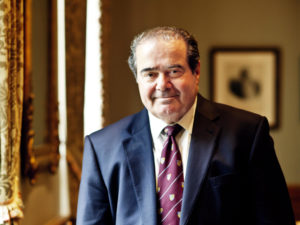
Justice Antonin Scalia at the Supreme Court in 2012.
October 10, 2016
October comes, and another term of the US Supreme Court begins. Except, for the first time since 1985, the justices sit without Antonin Scalia, who passed away in February. He received some proper and respectful eulogies at the time, although much of the media continued to misrepresent his judicial legacy, as they had done throughout his life. In time, honest historians will write comprehensively about that legacy. Here, I want just to highlight two recent cases that illustrate Scalia’s continuing influence. But doing so also serves as an occasion to review his judicial philosophy. I hope those who want to know more about Scalia’s thought find the following summary useful, and those already expert on the subject at least find it tolerably accurate.
Justice Scalia called himself a textualist, and an originalist. He believed that judges should interpret the laws by using time-honored rules of textual interpretation, and he devoted considerable effort to explaining those rules.1 To paraphrase both Scalia and Justice Oliver Wendell Holmes, judges should not inquire into what lawmakers might have intended, nor into the history of how a law was written. They should ask only what a law’s words reasonably mean. In the case of an older law, with words that might have changed in usage over time, textualists look at how informed people understood the law when enacted.2 Lastly, textualists acknowledge that our most fundamental law, the U.S. Constitution, contains many ambiguities. And that is necessarily so, since by design it covers very broad subjects in a compact, readable way.3 Justice Scalia therefore used the formula “Text and Tradition” to describe his approach. He looked first at the text of the Constitution. If ambiguity remained, he tried to resolve it by reading the words in light of the “longstanding legal traditions of the American people.”
Far too many journalists, including supposed legal experts, have created false impressions of textualism through sloth or spite. Commentators often lazily described Scalia as a “conservative” judge; they would then express surprise at his “liberal” rulings. For example, Scalia’s majority opinion in Kyllo v US overturned the conviction of an Oregon man who had illegally grown marijuana in his home. Federal agents had used a thermal imaging device, without a search warrant, to spot the defendant’s heat lamps from outside the house. Scalia’s opinion explained why that violated the Fourth Amendment.4 Did the “conservative” Scalia suddenly develop a soft spot for criminals? Did he secretly favor marijuana cultivation? No, and no. But as a judge, he faithfully upheld the constitutional text, even when that led to a result he personally disliked.
Conservatives, too, have used lazy and misleading language when discussing the courts. They long ago latched on to the term “judicial activism” to criticize judges who strike down laws duly enacted by Congress. Scalia avoided such terms, since they obscure the main issue: Does this particular law violate the original understanding of the Constitution? If not, then judges should leave it alone. But if so, then Scalia believed he was duty-bound to strike it down. For Scalia, judges could fail in their fidelity to the Constitution by passivity as surely as by “activism.” He excoriated his colleagues equally when they failed to protect clear constitutional principles, and when they invented new “rights” not set forth in the document’s text.
Just as they wrongly condemn “activism,” many conservatives praise, with similar carelessness, “strict constructionism.” The Republican nominee for vice president, Mike Pence, made that mistake in an op-ed just last week. Scalia had long ago addressed that particular error, writing: “A text should not be construed strictly, and it should not be construed leniently; it should be construed reasonably, to contain all that it fairly means.”5 The Court illustrated his point in 1993, when it reviewed an enhanced penalty for anyone who “uses a firearm” during commission of a drug-related crime.6 In that case, the defendant had offered to trade an unloaded firearm in exchange for cocaine. Did that mean he had used a firearm? The Court said yes. Scalia dissented, based on the principle that words in a statute should “be understood in their ordinary, everyday meanings.”7 As he wrote in dissent, “When someone asks, ‘Do you use a cane?’ he is not inquiring whether you have your grandfather’s silver handled walking stick on display in the hall; he wants to know whether you walk with a cane. Similarly, to speak of ‘using a firearm’ is to speak of using it for its distinctive purpose, i.e., as a weapon.”8 Once again, Scalia demonstrated that textualism means fidelity to the laws as written, regardless of whether the judge personally likes or dislikes the result.
When Scalia wrote the majority opinion in an important case, his devotion to principle gave his words a weightiness that lesser jurists could not match. But his outcome-neutral jurisprudence often put him at odds with his colleagues, most of whom sought particular results for ideological reasons. In the eyes of liberal commentators, that made Scalia a far less effective jurist than his onetime colleague, William Brennan. The latter’s vast influence had come not from great legal acumen, but from his unmatched skill at assembling Court majorities in landmark cases. Brennan was an undistinguished legal scholar but a masterful Court tactician. Scalia was the anti-Brennan. He didn’t do Court politics, and often wound up in the minority on major cases. But he crafted powerful dissents that shredded the majority opinions. He used colorful, stinging rhetoric to highlight his colleagues’ disregard for legal principles. Scalia’s opinions seldom carried the day in court, but they taught his philosophy to oncoming generations of lawyers, and demonstrated the shallowness and absurdity of the non-textualist position. Even as he lost individual battles, the cumulative influence of his opinions pushed American jurisprudence in a more honest, textualist direction.
Footnotes
- Antonin Scalia and Bryan Garner, Reading Law: The Interpretation of Legal Texts (Saint Paul: Thomas/West, 2012).
- Robert Bork described this concept with the phrase “the original understanding,” hence the term “originalism.”
- Compare, for brevity and style, the U.S. Constitution to the constitution of almost any one of the States.
- Kyllo v United States, 533 U.S. 27 (2001).
- Antonin Scalia, A Matter of Interpretation: Federal Courts and the Law (Princeton: Princeton University Press: 1997), 23.
- 18 U.S.C. § 924(c)(1)
- Scalia and Garner, Reading Law, 69.
- Smith v United States, 508 U.S. 223 (1993).



Leave A Comment
You must be logged in to post a comment.